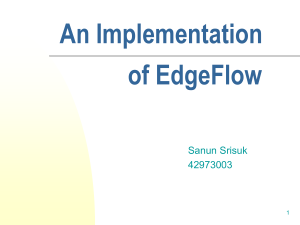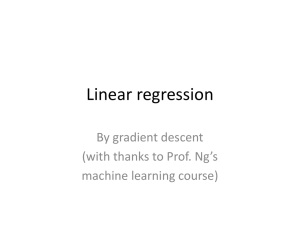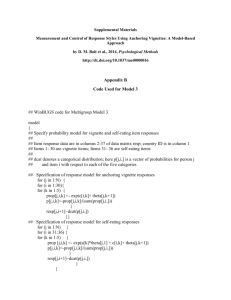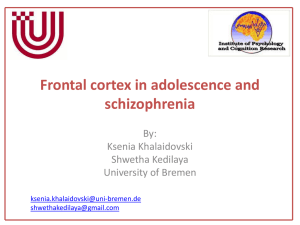DOC - CSE Home
advertisement
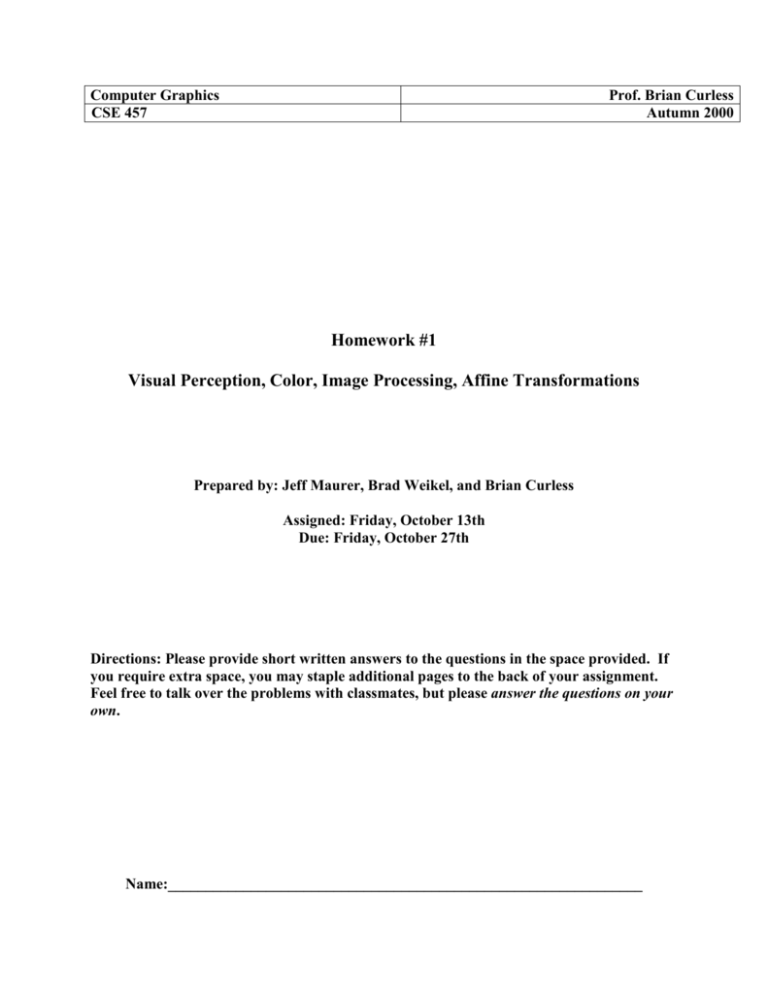
Computer Graphics CSE 457 Prof. Brian Curless Autumn 2000 Homework #1 Visual Perception, Color, Image Processing, Affine Transformations Prepared by: Jeff Maurer, Brad Weikel, and Brian Curless Assigned: Friday, October 13th Due: Friday, October 27th Directions: Please provide short written answers to the questions in the space provided. If you require extra space, you may staple additional pages to the back of your assignment. Feel free to talk over the problems with classmates, but please answer the questions on your own. Name:_______________________________________________________________ Problem 1. Short answer ( 14 points, 2 each) Provide a short answer (typically one or two sentences) to each of the following questions. In each case, you must clearly justify your answer. a. What is the primary tradeoff between using pinhole cameras and cameras with lenses? b. Describe the distribution of rods and cones in your eye. How is this related to acuity and sensitivity? c. At night, can we distinguish color differences or intensity differences better? d. How are the electrons coming out of the red, green, and blue electron guns of a color monitor different? e. At 24 bits per pixel (True Color), can a monitor produce every color perceptible to the human eye? f. Is the median filter a convolution filter? g. If you convolve an image with the Laplacian filter, will you typically get an image that looks about the same except a bit sharper? 2 Problem 2. Color perception (25 points) Prakites, aliens from the planet Prakon-7, have two types of cones, S-cones and L-cones. These cones have spectral sensitivities s() and l(), respectively, as shown below: (Note that we are drawing both functions on one graph) (a) (10 points) Prakon-7 is part of a three-star system, the stars having emission spectra as shown below. Determine which, if any, of these stars appear as metamers for the Prakites. 3 4 Problem 2 (cont.) (b) (10 points) The surface of Prakon-7 is dominated by a material with surface reflectance R() shown below. Determine under which of the three stars, if any, the surface will yield subtractive metamers for the Prakites. (You need only consider the reflection of one star at a time. Do not worry about contributions from multiple stars.) (c) (5 points) The Prakites build their homes using a material with a spectral reflectance that attenuates light selectively at each wavelength. Consider light with an arbitrary spectrum shining on one of these Prakite houses. A Prakite’s LS cone responses to the light that first reflects off the building and to the light that comes directly to the eye are the same; i.e., the reflected light and the direct (unreflected) light are metamers to the Prakites. What restriction(s) do these circumstances place on the spectral reflectance of the construction material? Justify your answer. 4 5 Problem 3. Image warping (24 points, 4 points per image pair) Consider image warping functions of the form: f(x,y) g(x, y) = f(X(x,y), Y(x,y)) and f(r, theta) g(r, theta) = f(R(r, theta), THETA(r, theta)) where (x,y) is a point in Cartesian coordinates and (r, theta) is point in polar coordinates. y r r theta aaaaa (0,0) x (0,0) (0,0) Cartesian Coordinates Polar Coordinates For each image pair on the following page, determine which image warping function below best describes how the left image is transformed into the second. Write the number of the image pair in the space next to the corresponding warping function. Note that there are more warping functions than image pairs, so some of the spaces will be left blank. (Hint: recall from class that doubling the x-coordinate corresponded to halving the width of the output image, so there is some kind of inverse relationship at work here. Also, a “negative radius” corresponds to a positive radius with 180 degrees added to theta.) ____ X = x Y = -2.0 * y ____ X = x Y = y / -2.0 ____ X = x Y = -y^2 ____ X = 120.0 * cos(x/40.0) Y = 120.0 * sin(y/40.0) ____ R = sqrt(r * 80.0) THETA = -theta ____ R = r THETA = theta + r/100.0 ____ R = r THETA = sqrt(theta) ____ R = r – 60.0 THETA = theta ____ R = theta THETA = r 5 6 Problem 3 (cont.) I. II. III. IV. V. VI. 6 7 Problem 4. Image filters (15 points, 5 each) For each image pair, suggest a filter operation that will take the left image and produce the right image. Justify your choice of filter in words. Feel free to look at the original images with the “snoop” tool, though you should be sure to display the images at high resolution before snooping. (a) (b) (c) 7 8 Problem 5. Affine Transformations (37 points) A= D= G= 1 0 0 6 1 0 0 0 0 -1 0 0 0 1 0 3 0 0 1 0 1 0 0 0 0 0 1 2 0 -1 0 0 0 0 1 0 0 0 0 1 0 0 0 1 0 0 0 1 2 0 0 0 2 0 0 0 1 0 0 0 0 2 0 0 0 3 0 0 1 1 0 0 0 0 2 0 0 0 2 0 0 0 1 0 0 0 0 1 0 0 0 1 0 0 0 1 1 0 0 0 1 0 -1 0 1 0 0 1 0 1 0 0 0 1 0 0 0 .6 .8 0 0 0 -1 0 1 0 1 0 0 -.8 .6 0 0 0 0 1 0 0 0 1 0 0 0 1 B= E= H= C= F= I= (a) (2 points per matrix) As discussed in class, any three-dimensional affine transformation can be represented with a 4x4 matrix. Match the matrices above to the following transformations (not all blanks will be filled): ____ Differential (Non-Uniform) Scaling ____ Reflection ____ Rotation about the z-axis with non-uniform scaling ____ Rotation about the y-axis with non-uniform scaling ____ Translation ____ Rotation about the x-axis ____ Rotation about the y-axis ____ Rotation about the z-axis ____ Shearing with respect to the x-y plane ____ Shearing with respect to the y-z plane ____ Rotation about the x-axis and translation ____ Uniform Scaling ____ Reflection with uniform scaling 8 9 Problem 5 (cont.) (b) (7 points) In the figure below, an affine transformation has been applied to the geometry drawn with dotted lines to arrive at the geometry drawn with solid lines. Determine a product of 3x3 matrices that perform this transformation. Do not multiply the matrices out. There is more than one way to arrive at an answer, so please explain your reasoning. 9 10 Problem 5 (cont.) (c) (12 points) A plane can be described by the following equation and figure: where is the normal to the plane and d is the closest distance between the origin and the plane (which happens to be along the same direction as the normal). See figure below. Consider a plane with a normal vector of (cos , sin , 0). The equation for this plane can be simplified to: x cos + y sin = d Write out the product of matrices that would perform a reflection across this plane. Do not multiply the matrices out. Show your work. 10
